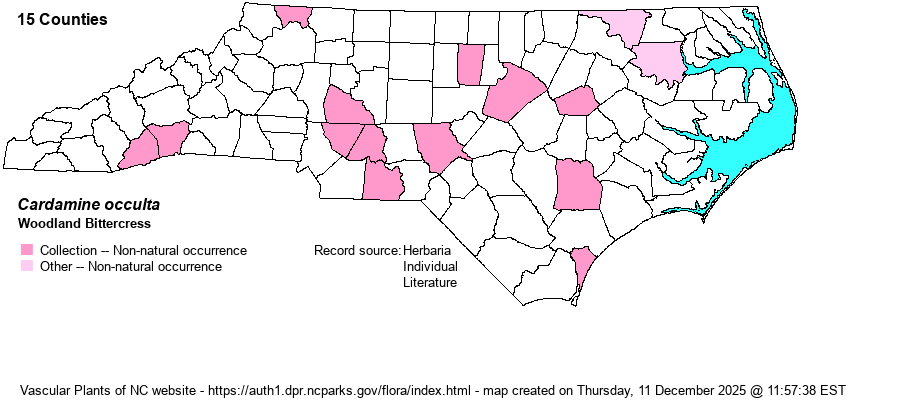| Author | Hornemann | |
| Distribution | Scattered across the state, but with large gaps. Appears to be spreading in the past 2 decades and we expect it to turn up in additional counties. First collected in 1956 in a lawn in New Hanover County and on a roadside in 1957 in Rowan County. NOTE: see Taxonomic Comments.
Native of Europe and eastern Asia; in N.A. Newf. to Ont. south to FL and TX; also B.C. to CA. | |
| Abundance | Rare, so far as is known. But, it can be locally numerous, as in roadside ditches in Whispering Pines, Moore County. | |
| Habitat | Moist to wet soils of swamp forests, roadside ditches, roadsides, river margins, near waterfalls, lawn weed, nursery weed. | |
| Phenology | Flowering and fruiting March-May. | |
| Identification | Woodland Bittercress may be mistaken for the ubiquitous C. hirsuta, but the lower stems are pubescent (vs. glabrous in C. hirsuta) and the stems root at the nodes (vs. not and thus more erect in the latter). Robust, multi-stem plants may resemble the native C. pensylvanica, but the lower petioles are ciliate (vs. not ciliate in that species). | |
| Taxonomic Comments | Weakley (2018) has replaced the name flexuosa with occulta Hornemann. Apparently most N.A. specimens thought to be the European flexuosa actually belong to the east Asian occulta; see FNA (2010) for discussion.
| |
| Other Common Name(s) | | |
| State Rank | SE | |
| Global Rank | GNR | |
| State Status | | |
| US Status | | |
| USACE-agcp | | |
| USACE-emp | | |

